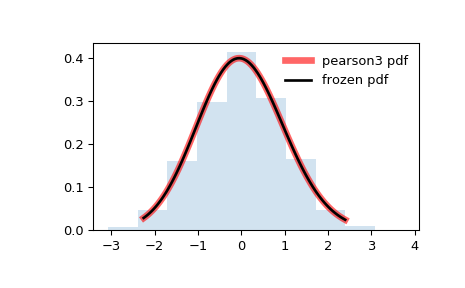scipy.stats.pearson3¶
-
scipy.stats.pearson3= <scipy.stats._continuous_distns.pearson3_gen object>[source]¶ A pearson type III continuous random variable.
As an instance of the
rv_continuousclass,pearson3object inherits from it a collection of generic methods (see below for the full list), and completes them with details specific for this particular distribution.Notes
The probability density function for
pearson3is:\[f(x, skew) = \frac{|\beta|}{\Gamma(\alpha)} (\beta (x - \zeta))^{\alpha - 1} \exp(-\beta (x - \zeta))\]where:
\[\beta = \frac{2}{skew stddev} \alpha = (stddev \beta)^2 \zeta = loc - \frac{\alpha}{\beta}\]\(\Gamma\) is the gamma function (
scipy.special.gamma).pearson3takesskewas a shape parameter for \(skew\).The probability density above is defined in the “standardized” form. To shift and/or scale the distribution use the
locandscaleparameters. Specifically,pearson3.pdf(x, skew, loc, scale)is identically equivalent topearson3.pdf(y, skew) / scalewithy = (x - loc) / scale.References
R.W. Vogel and D.E. McMartin, “Probability Plot Goodness-of-Fit and Skewness Estimation Procedures for the Pearson Type 3 Distribution”, Water Resources Research, Vol.27, 3149-3158 (1991).
L.R. Salvosa, “Tables of Pearson’s Type III Function”, Ann. Math. Statist., Vol.1, 191-198 (1930).
“Using Modern Computing Tools to Fit the Pearson Type III Distribution to Aviation Loads Data”, Office of Aviation Research (2003).
Examples
>>> from scipy.stats import pearson3 >>> import matplotlib.pyplot as plt >>> fig, ax = plt.subplots(1, 1)
Calculate a few first moments:
>>> skew = 0.1 >>> mean, var, skew, kurt = pearson3.stats(skew, moments='mvsk')
Display the probability density function (
pdf):>>> x = np.linspace(pearson3.ppf(0.01, skew), ... pearson3.ppf(0.99, skew), 100) >>> ax.plot(x, pearson3.pdf(x, skew), ... 'r-', lw=5, alpha=0.6, label='pearson3 pdf')
Alternatively, the distribution object can be called (as a function) to fix the shape, location and scale parameters. This returns a “frozen” RV object holding the given parameters fixed.
Freeze the distribution and display the frozen
pdf:>>> rv = pearson3(skew) >>> ax.plot(x, rv.pdf(x), 'k-', lw=2, label='frozen pdf')
Check accuracy of
cdfandppf:>>> vals = pearson3.ppf([0.001, 0.5, 0.999], skew) >>> np.allclose([0.001, 0.5, 0.999], pearson3.cdf(vals, skew)) True
Generate random numbers:
>>> r = pearson3.rvs(skew, size=1000)
And compare the histogram:
>>> ax.hist(r, density=True, histtype='stepfilled', alpha=0.2) >>> ax.legend(loc='best', frameon=False) >>> plt.show()

Methods
rvs(skew, loc=0, scale=1, size=1, random_state=None)
Random variates.
pdf(x, skew, loc=0, scale=1)
Probability density function.
logpdf(x, skew, loc=0, scale=1)
Log of the probability density function.
cdf(x, skew, loc=0, scale=1)
Cumulative distribution function.
logcdf(x, skew, loc=0, scale=1)
Log of the cumulative distribution function.
sf(x, skew, loc=0, scale=1)
Survival function (also defined as
1 - cdf, but sf is sometimes more accurate).logsf(x, skew, loc=0, scale=1)
Log of the survival function.
ppf(q, skew, loc=0, scale=1)
Percent point function (inverse of
cdf— percentiles).isf(q, skew, loc=0, scale=1)
Inverse survival function (inverse of
sf).moment(n, skew, loc=0, scale=1)
Non-central moment of order n
stats(skew, loc=0, scale=1, moments=’mv’)
Mean(‘m’), variance(‘v’), skew(‘s’), and/or kurtosis(‘k’).
entropy(skew, loc=0, scale=1)
(Differential) entropy of the RV.
fit(data, skew, loc=0, scale=1)
Parameter estimates for generic data.
expect(func, args=(skew,), loc=0, scale=1, lb=None, ub=None, conditional=False, **kwds)
Expected value of a function (of one argument) with respect to the distribution.
median(skew, loc=0, scale=1)
Median of the distribution.
mean(skew, loc=0, scale=1)
Mean of the distribution.
var(skew, loc=0, scale=1)
Variance of the distribution.
std(skew, loc=0, scale=1)
Standard deviation of the distribution.
interval(alpha, skew, loc=0, scale=1)
Endpoints of the range that contains alpha percent of the distribution
